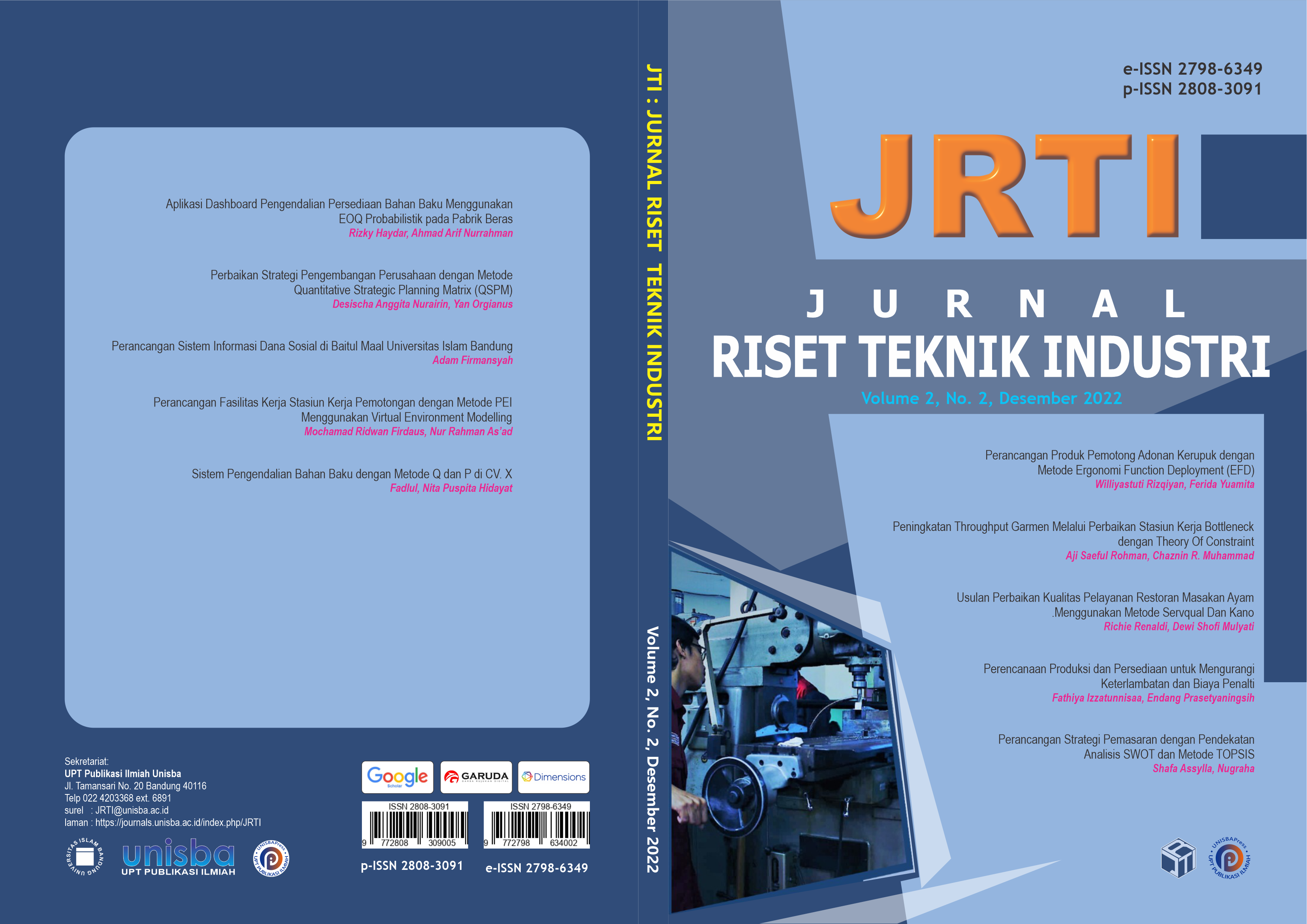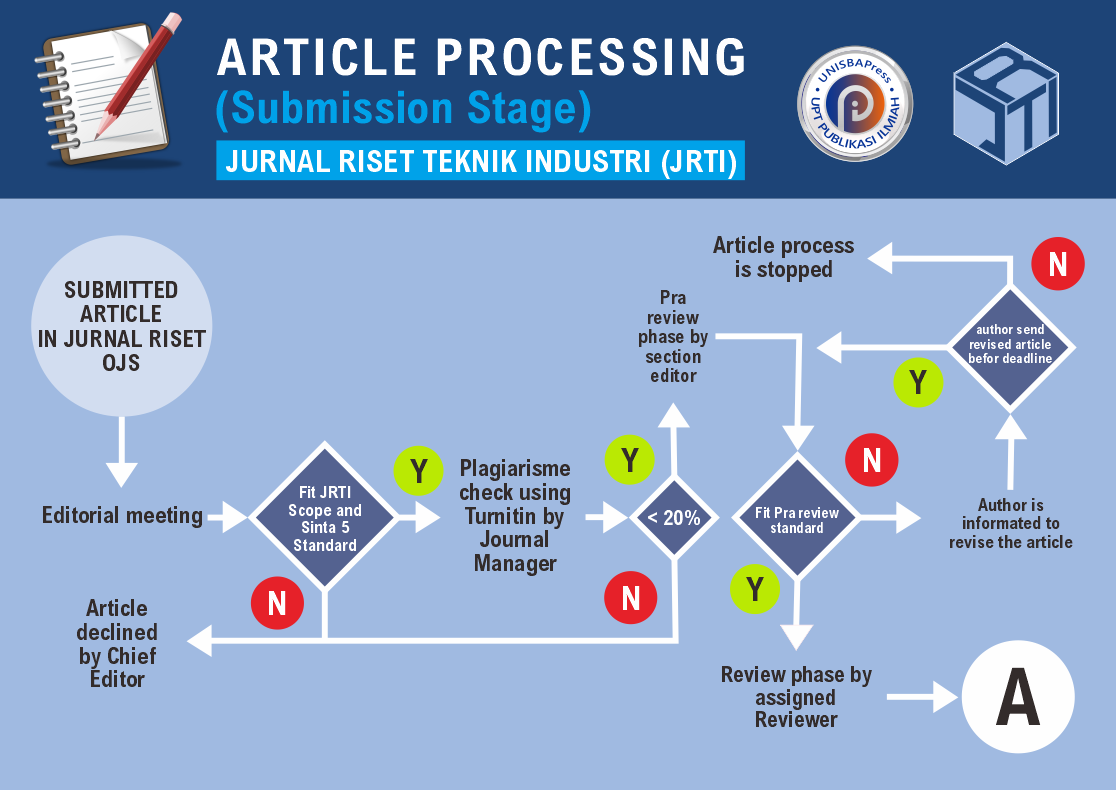Peningkatan Throughput Garmen melalui Perbaikan Stasiun Kerja Bottleneck dengan Theory of Constraint
DOI:
https://doi.org/10.29313/jrti.v2i2.1138Keywords:
Theory of Constraint, Kapasitas, ThroughputAbstract
Abstract. PT. L is a company engaged in the garment sector. The obstacle encountered in this company is work in process at the Sewing Work Station and the Finishing Work Station and there are work stations are idle at the Embroidery Work Station. These constraints are caused by an unbalanced capacity occurs due to differences in the operating process time at each work station. Therefore, capacity must be increased so that demand can be met and the resulting throughput is maximized. This increase can be done by implementing the Theory of Constraint steps starting from the identification of constraints, exploitation of constraints, subordination of other sources and elevation of constraints.The final result of the application of the theory of constraint is the application of overtime at the constraint work station, namely Sewing 1, an additional overtime is added for one hour and for Finishing 1,2 3 and Packaging 1, two hours each. The increase that occurs is in the utility of work stations for Sewing 1 from 104.70% to 91.96% while for Finishing 1, 2, 3 and Packaging 1, respectively from 123.18%, 127.87%, 116.73% and 124.12% to 95.81%, 99.45%, 90.79% and 96.54%, respectively. With the increase in capacity, the Throughput obtained has increased from Rp. 1,033,868,000 to Rp 1,274,504,000.
Abstrak. L merupakan suatu perusahaan yang bergerak dalam bidang garmen. Gejala yang ditemui pada perusahaan ini yaitu terjadi penumpukkan barang setengah jadi pada Stasiun Kerja Sewing dan Stasiun Kerja Finishing serta terdapat stasiun kerja yang mengalami idle pada Stasiun Kerja Embroidery yang disebabkan oleh kapasitas yang tidak seimbang karena perbedaan waktu proses operasi pada setiap stasiun kerja. Oleh karena itu, kapasitas harus ditingkatkan agar permintaan dapat dipenuhi dan throughput yang dihasilkan menjadi maksimal. Peningkatan tersebut dapat dilakukan dengan penerapan langkah – langkah Theory of Constraint mulai dari identifikasi constraint, eksploitasi constraint, subordinasi sumber lain serta elevasi constraint. Hasil akhir dari penerapan theory of constraint yaitu berupa penerapan overtime pada Stasiun Kerja constraint yaitu Stasiun Kerja Sewing 1 dilakukan penambahan waktu overtime sebanyak satu jam dan untuk Stasiun Kerja Finishing 1,2 3 dan Packaging 1 masing – masing sebanyak dua jam. Peningkatan yang terjadi yaitu terdapat pada utilitas stasiun kerja untuk Stasiun Kerja Sewing 1 dari 104,70% menjadi 91,96% sedangkan untuk stasiun kerja Finishing 1, 2, 3 dan Packaging 1 masing – masing dari 123,18%, 127,87%, 116,73% dan 124,12% menjadi 95,81%, 99,45%, 90,79% dan 96,54%. Adanya peningkatan kapasitas tersebut, maka throughput yang didapatkan mengalami peningkatan dari Rp. 1.033.868.000 menjadi Rp 1.274.504.000
References
J. R. Tersine, Principles of Inventory and Material Management, 4th ed. New Jersey: PTR Prentice Hall,Inc., 1994.
Gusnardi, “TOC : Tinjauan Teori,” Pekbis J., vol. 2, no. 3, pp. 336–345, 2010.
M. Sulistiowati, “Penerapan TOC Sebagai Alat Bantu Untuk Mengidentifikasi Kendala Dalam Proses Produksi Pada PT. Panca Mas Jaya Prakarsa,” STIE Malang, Malang, 2004.
D. R. Hansen and M.M. Mowen, Cost Management: Accounting and Control. Singapore: South-Western, 2000.
E. M. Goldratt and J. Cox, The Goal: A Process of Ongoing Improvement, 4th ed. New York: North River Press, 2004.
I. Z. Sutalaksana, R. Anggawisastra, and J. H. Tjakraatmadja, Teknik Perancangan Sistem Kerja , 2nd ed. Bandung: ITB Press, 2006.
S. Wignjosoebroto, Teknik Tata Cara dan Pengukuran Kerja. Surabaya: Laboratorium Ergonomi dan Teknik Tata Cara ITS, 1989.
T. T. Dimyati and A. Dimyati, Operation Research (Model-model Pengambilan Keputusan). Bandung: Sinar Baru Algesindo, 2018.
W. H. Dettmer, Goldratt’s Theory of Constraints A System Approach to Continuous Improvement. Winconsin: ASQ Quality Press, 1997.
E. T. Susdarwono, “PEMROGRAMAN LINIER PERMASALAHAN EKONOMI PERTAHANAN: METODE GRAFIK DAN METODE SIMPLEKS,” Teorema Teor. dan Ris. Mat., vol. 5, no. 1, p. 89, Mar. 2020, doi: 10.25157/teorema.v5i1.3246.












